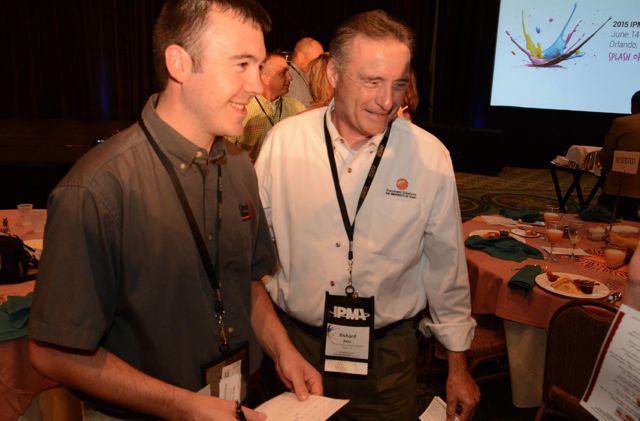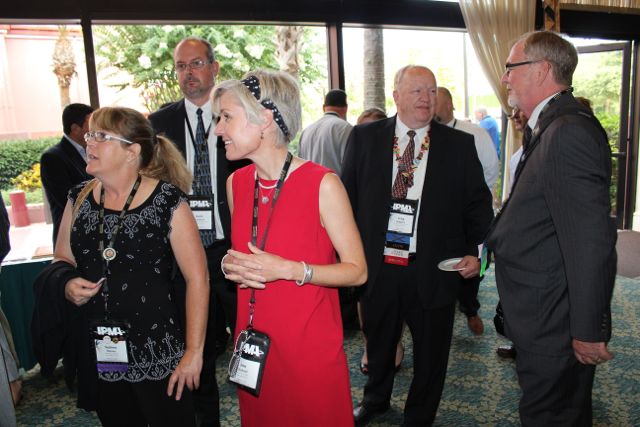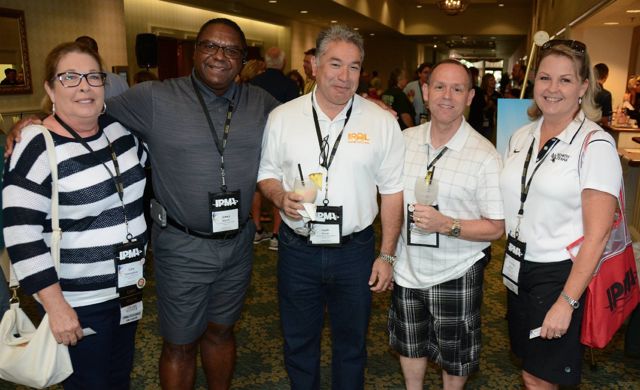IPMA 2015: An App-solute Success

If there was one thing that distinguished last month’s In-plant Printing and Mailing Association conference from all past IPMA events it was this: the app.
At a conference where social media was embraced with a bear hug, the new IPMA conference app ushered in a monumental change in the way attendees interacted, received information and shared updates during the time they were together. Throughout the four-day conference in Orlando, FL, attendees were seen checking the agenda on their mobile devices, selecting sessions to attend, rating speakers and (of course) posting photos and status updates using the new IPMA app. They could also send messages to other attendees, take surveys, get information on exhibitors and more.
“I really enjoyed the app and the functionality,” affirmed Robbie Feazel, manager of Print, Mail and Procurement at Federal Home Loan Bank of Atlanta. “It put the conference at your fingertips 24/7.”
Unlike at most conferences, where furtive checking of mobile devices is tacitly frowned upon, at this event it seemed OK. Some speakers, like Grow Socially’s John Foley, even encouraged it, as he told in-plants about the value of using social media, e-newsletters, content marketing and YouTube videos to promote their success.
Yet clearly the app—and the mobile devices it depended on—was also a distraction, splitting people’s attention from sessions and even, ironically, from some of the face-to-face socializing opportunities. Still, the flow of photos and updates from attendees did bring people together who may not have otherwise met one another.
“This was the best conference I have attended,” declared Sylvia Marmon, with the City of Boise, ID. “The app really made the difference, I think, by connecting everyone and giving us the conference info at our fingertips.”
A New Direction
The IPMA app wasn’t the only thing unique about this year’s conference, which brought about 125 in-plant managers to Orlando’s Caribe Royale Hotel during a stretch of very hot, sunny days (juxtaposed with very cold meeting rooms).
The awards banquet, usually the climax of the event, was instead held on the very first night.
The opening “get acquainted” reception, which normally takes place in the host hotel, was moved off-site to the Universal CityWalk entertainment district. Sponsored by Konica Minolta, it was a much more elegant kickoff than usual.
The vendor fair didn’t begin until the second day of the conference, and it ran just a day and a half. It was delayed, in part, to give vendors a break from the inflated costs of setting up on Sunday, and shortened because vendor fair attendance historically drops by the end of the second day.
The agenda included hour-long gaps between sessions, which, for those craving education, probably seemed like wasted time, but turned out to create a relaxed opportunity for networking. And there did seem to be a lot more socializing this year. (I made more contacts than usual and heard many interesting stories: in-plants taking over MFD fleets, gaining the right of first refusal, and making plans to fire facilities management firms and take back their in-plants.)
Without the formal banquet to culminate the conference, the last night was instead turned over to an adventurous outing in the Florida back country, sponsored by Xerox, which included air boat rides, alligator feeding and a barbecue dinner (featuring fried gator chunks and frog legs).
An Unexpected Rearrangement
Perhaps the most surprising change in this otherwise forward-looking conference was the news of a throwback in leadership: former IPMA President Rob Lingard, of Deseret Mutual, announced that he was stepping back in as president after the unexpected resignation of Alvin Griffin. This revelation caused a bit of a stir during the conference, though it didn’t seem to affect the flow of the event. Reached after the conference, Griffin explained his tough decision:
“Our superintendent of schools recently challenged the leadership team to be more intentional with our personal and professional resources. I took a hard look at where I was personally and professionally and realized that I could not be ‘all-in’ with IPMA and ‘all-in’ with Charlotte-Mecklenburg Schools and our community. In all fairness to the association, the board of directors and I concluded it would be in the best interest of IPMA for me to resign the position and allow the association to move forward with leadership that could dedicate a little more resources.”
Griffin’s difficult decision underscores the fact that in-plant managers serve their parent organizations above all else.
A Top-class Conference

Best of Show winners Excellus BlueCross BlueShield and Brigham Young University show off their trophies during the awards ceremony.
Those who were able to get away from their print shops for the conference were extremely upbeat about the quality of the event, and especially about the ability it offered them to meet other in-plant managers and talk shop.
“I really enjoyed the IPMA conference,” enthused Robert Cisneros, manager of in-house printing at Farmers Insurance, in Chino, CA. “The atmosphere was open to dialogue between in-plant printing professionals, who were candid with the struggles and accomplishments that we encounter on a daily basis. The sharing of solutions of what has worked for their particular plants was a good learning experience, and the information provided by the vendors and consultants was valuable to help measure where your shop is at, and what needs to be done for the future.”
Coming all the way from Australia, Craig Gibbs of Deakin University, also praised the networking opportunities at IPMA. "What makes it stand out for me is the quality of the speakers and the way they are prepared to share information," he said. "It never ceases to amaze me that regardless of what part of the world we come from, print and mail shop managers all experience the same issues, and by attending these conferences we come up with many solutions."
Added Feazel, of Federal Home Loan Bank of Atlanta: “The most valuable part of the conference is the people. It’s nice being able to network and hear from others what challenges they face, what solutions they come up with and discuss what the future of our industry looks like.”
The vendor fair, despite its later-than-usual start, was a big hit, and always seemed to be bustling.
“I’ve attended and exhibited at countless conferences over the past 20 years, but this was certainly the best,” proclaimed John Langan, of Imprints USA. “It was professional and fun—and the app is tremendous.”
His praise was echoed by other vendors: “Many thanks to … the conference-planning team for a stellar event,” lauded Lucy Perez, of Xerox (in a comment posted via the app). “It was amazing and insightful to listen and learn from all of you. I am looking forward to IPMA 2016 in Colorado.”
Yes, next year’s conference will be in the Denver area, and will no doubt include a tour of incoming IPMA President Mike Lincoln’s award-winning state printing operation.
Early Awards Banquet
Moving the awards ceremony to the first night, which hasn’t happened in a decade, seemed a good decision. Attendees had the rest of the week to talk with and congratulate the winners—particularly the In-Print Best of Show winners, Brigham Young University and Excellus BlueCross BlueShield. Also recognized were:
- IPMA’s Print Center of the Year winner: The University of Texas at Austin Document Solutions.
- The Mail Center of the Year winner: Excellus BCBS Document Services.
- The In-house Promotional Excellence Award winner: University of North Texas Printing and Distribution Solutions.
- The Innovation Award winner: Messiah College Press.
- The Outstanding Contributor Award winner: Elisha Kasinskas, of Rochester Software Associates.
During the conference, IPMA staff spent a good amount of time plugging the association’s recently revamped website (www.IPMA.org) and urging members to take advantage of its information-sharing and community-building features. The new site includes blogs, a job board, equipment for sale, and—perhaps the most impressive new feature—a members-only online community called IPMA Exchange, where members can share information, collaborate, ask questions, solve problems and keep in touch. It will also include articles, webinar recordings, presentations and more.
During a membership town hall meeting, board members noted that IPMA has contracted with Grow Socially to aid in its marketing efforts and to help build membership.
“We are committed to growing the organization,” stressed Lingard.
In-plant Panels Galore
More than usual, many of the sessions this year featured panels of in-plant managers sharing best practices. The first was a session coordinated by Rochester Software Associates in which four managers shared ideas for new services and new ways to engage customers.
- Frank Savino, of Yale University, talked about a new invoice scanning service and the use of PaperCut software on the MFD fleet to encourage sustainability.
- Lora Connaughton, of the University of North Texas, noted that becoming a promotional products distributor has gained her in-plant half a million dollars in additional revenue this year.
- Tammy Golden, with the State of Tennessee, talked about new services her shop is providing, like gallery-wrapped canvas prints, which are proving popular and bringing in revenue.
- Linda Winn, of Shelter Insurance, noted that a new wide-format printer has enabled her shop to print on vinyl, mesh, foam core and more, and produce unique products like window graphics and car decals. Her shop makes videos to demonstrate installation for customers.
To read more of the ideas and thoughts shared by these managers, download the Colorful In-Plant Ideas booklet from RSA.
I moderated another panel discussion, this one covering production inkjet printing. It featured Catherine Ciardi, of Excellus BCBS; Dave Leonard, with The World Bank Group; and Mike Lincoln, Colorado state printer. The trio related their experiences, good and bad, with their new inkjet presses, including the struggle to find the right papers to print on. The savings in print costs enabled by their inkjet presses, they agreed, combined with new work they have been able to secure, justified the high initial cost of the machines.
“There is a significant savings when you’re migrating from toner to inkjet,” proclaimed Ciardi.
She and Lincoln also sat on another panel, with Brian Patterson of Briggs & Stratton, and John Sarantakos of the University of Oklahoma. There, Lincoln talked about how he has moved into a consulting role with his agency customers, helping them see the benefits of adding color to their pieces. Patterson noted that locating one of his in-plant’s designers in the company’s marketing department has fostered a great relationship with marketing. Sarantakos stressed the importance of looking for unsatisfied customer needs and
adding services to fill them. His in-plant has also become a dealer of promotional products, and is bringing in $700,000 a year from this.
 During that session, Ciardi showed off her strategic plan: a three-ring binder packed with data on the cost of ownership of her shop’s equipment, budgeted hourly rates, the in-plant’s mission and vision, pricing comparisons, jobs won and lost by the in-plant, the pro’s and con’s of in-house printing, and more—all detailed and waiting for the next challenge to her in-plant’s value. She recommended every in-plant put together such a book and have it ready.
During that session, Ciardi showed off her strategic plan: a three-ring binder packed with data on the cost of ownership of her shop’s equipment, budgeted hourly rates, the in-plant’s mission and vision, pricing comparisons, jobs won and lost by the in-plant, the pro’s and con’s of in-house printing, and more—all detailed and waiting for the next challenge to her in-plant’s value. She recommended every in-plant put together such a book and have it ready.
Yet another panel at the conference brought together Paul Bethel, of BCBS of Louisiana, Robert Cisneros, of Farmers Insurance, and Chris Donlon, of Kohler Corp. They talked about the importance of cross training, empowering employees to make decisions, providing great customer service and more.
Greet Customers as Friends
Marketing and customer service were recurring themes at the conference, starting from the very first keynote speaker, Patrick Henry, who—in between strumming humorous songs on his guitar—stressed that to inspire loyalty, in-plants must greet customers as friends and create “rememberability.” He advised them to adopt an “extra inch mentality,” noting that anything you do, you must be willing to sign your name to it. Don’t have a “point-the-way mentality” (i.e., pointing to a sign instead of actually helping customers), but rather adopt a “lead-the-way mentality,” which will spawn lifelong customer loyalty.
In another session, Tammy Slone, of Cedarville University, related how her in-plant has developed partnerships with various departments on campus, the most vital being the relationship with marketing. Since marketing is the guardian of the school’s logo, the in-plant is helping marketing ensure the logo is used properly by offering discounts for work that passes through the designers in marketing before reaching the in-plant.
An in-plant’s continued relevance, Slone noted, stems from how vital their role is in conjunction with the mission of the parent organization. Building relationships is the best way to remain relevant. It also allows the in-plant to discover the unmet needs of these customers.
In a session about marketing the in-plant in a K-12 setting, Erica Derrington, of Olathe Public Schools, talked about having open houses and face-to-face meetings with customers. Others in the audience shared their ideas for building customer relationships.
In his lunchtime keynote session, Foley discussed the crucial need for in-plants to market their services. YouTube, he revealed, is the number two search engine. Take advantage of this and create videos showing off what you can do, he said. When a customer thanks you for a job well done, make a video testimonial of them to share their satisfaction with others.
 Foley urged in-plants to stop selling a commodity (print) and transform their businesses to better respond to customers’ changing needs. Cross-media marketing, digital asset management and variable data printing should all be in your sights. He stressed the need to think differently and keep your eyes and ears open for new opportunities. But before jumping into a full transformation, make sure to create business, marketing and financial plans, he advised.
Foley urged in-plants to stop selling a commodity (print) and transform their businesses to better respond to customers’ changing needs. Cross-media marketing, digital asset management and variable data printing should all be in your sights. He stressed the need to think differently and keep your eyes and ears open for new opportunities. But before jumping into a full transformation, make sure to create business, marketing and financial plans, he advised.
In some sessions, managers talked about how they had transformed their operations to add more value. Todd Graham, from Delta Dental of Michigan, described how his in-plant improved its workflow, worked to control costs and repaired staff/management relationships. He also described future changes, like implementing Web-to-print, improving customer ordering and moving to a chargeback system.
Marmon, with the City of Boise, related her in-plant’s experiences after a consultant was hired to review the copier situation at all city locations. After reducing the number of devices from 545 to 380, she tracked a 6 percent reduction in pages printed and a 24 percent cost reduction for the city.
Outsourcing Boosts Relevance
Abbas Badani, of the Pennsylvania State University, related how the e-commerce print procurement site he created has improved his in-plant’s strategic relevance, while cutting costs and providing more transparency. All vendors must bid electronically through the PSU Print Portal, including the in-plant. Jobs are awarded based on which vendor offers the best value. The Portal tracks job status, shows job price history and scores vendors on pricing, service, quality and on-time delivery. Because the in-plant has the opportunity to see all the work, he said, it can position itself to deliver value where it can be most effective. The portal provides a platform for the in-plant to talk to customers, understand their needs and partner with them.
The conference included technical sessions as well. Some covered mail piece design, implementing Web-to-print, intelligent packing systems and copier fleet management. In his session on “technical aspects of printing every print manager should know,” Brad Johnson, of the Church of Jesus Christ of Latter-day Saints, led an animated discussion on various topics, such as color management, inkjet technology, automation and time tracking, to name a few.
In the end, though, the 2015 IPMA conference will be remembered not so much for the educational sessions as for its enhanced focus on networking, whether through the conference app and new website community or through the many opportunities for face-to-face conversation during the event.
Related story: IPMA Flashback: Become a ‘World Class In-plant’

Bob has served as editor of In-plant Impressions since October of 1994. Prior to that he served for three years as managing editor of Printing Impressions, a commercial printing publication. Mr. Neubauer is very active in the U.S. in-plant industry. He attends all the major in-plant conferences and has visited more than 180 in-plant operations around the world. He has given presentations to numerous in-plant groups in the U.S., Canada and Australia, including the Association of College and University Printers and the In-plant Printing and Mailing Association. He also coordinates the annual In-Print contest, co-sponsored by IPMA and In-plant Impressions.
 From the Editor: Multitasking Fatigue
From the Editor: Multitasking Fatigue
 IPMA Conference Splashes Down in Orlando
IPMA Conference Splashes Down in Orlando
 Increasing Value with Expanded Services: In-plant Opportunities to Become a Turnkey Communications Partner
Increasing Value with Expanded Services: In-plant Opportunities to Become a Turnkey Communications Partner
 From the Editor: Outflanking Outsourcing
From the Editor: Outflanking Outsourcing
 Outside In: How Insourcing Helps In-plants Thrive
Outside In: How Insourcing Helps In-plants Thrive
 Overlooked Opportunities: Shredding It in New York
Overlooked Opportunities: Shredding It in New York








